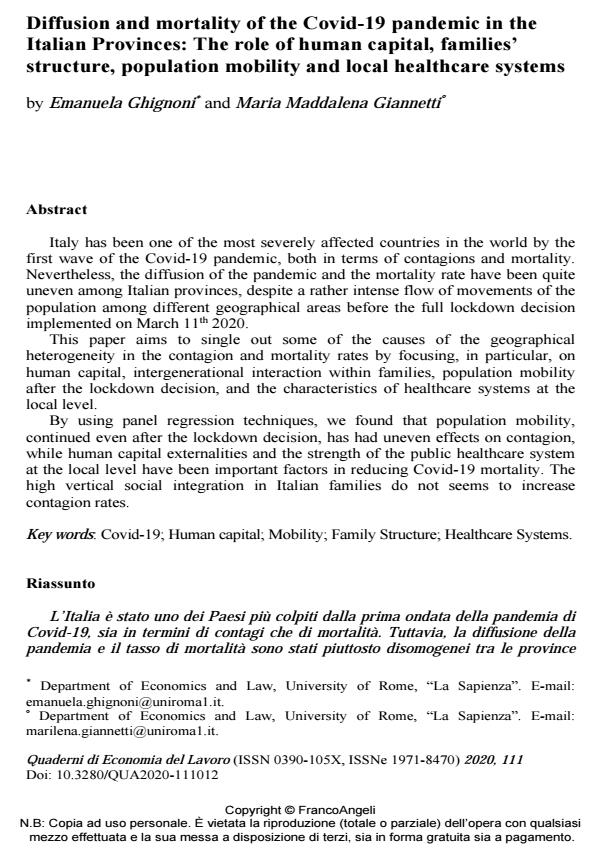Diffusion and mortality of the Covid-19 pandemic in the Italian Provinces: The role of human capital, families' structure, population mobility and local healthcare systems
Titolo Rivista QUADERNI DI ECONOMIA DEL LAVORO
Autori/Curatori Emanuela Ghignoni, Maria Maddalena Giannetti
Anno di pubblicazione 2021 Fascicolo 2020/111
Lingua Inglese Numero pagine 26 P. 263-288 Dimensione file 3010 KB
DOI 10.3280/QUA2020-111012
Il DOI è il codice a barre della proprietà intellettuale: per saperne di più
clicca qui
Qui sotto puoi vedere in anteprima la prima pagina di questo articolo.
Se questo articolo ti interessa, lo puoi acquistare (e scaricare in formato pdf) seguendo le facili indicazioni per acquistare il download credit. Acquista Download Credits per scaricare questo Articolo in formato PDF

FrancoAngeli è membro della Publishers International Linking Association, Inc (PILA)associazione indipendente e non profit per facilitare (attraverso i servizi tecnologici implementati da CrossRef.org) l’accesso degli studiosi ai contenuti digitali nelle pubblicazioni professionali e scientifiche
L’Italia è stato uno dei Paesi più colpiti dalla prima ondata della pandemia di Covid-19, sia in termini di contagi che di mortalità. Tuttavia, la diffusione della pandemia e il tasso di mortalità sono stati piuttosto disomogenei tra le province italiane, nonostante un intenso flusso di movimenti della popolazione tra le diverse aree geografiche del paese prima del lockdown dell’11 marzo 2020. Questo articolo si propone di individuare alcune delle cause dell’eterogeneità geografica del contagio e del tasso di mortalità, concentrandosi in particolare sul ruolo del capitale umano, dell’interazione intergenerazionale all’interno delle famiglie, della mobilità della popolazione dopo la decisione di lockdown e delle caratteristiche dei sistemi sanitari a livello locale. Tramite l’utilizzo di tecniche panel, troviamo che la mobilità della popolazione, parzialmente continuata anche con il lockdown, ha avuto effetti disomogenei sull’espansione del contagio, mentre le esternalità del capitale umano e l’estensione del sistema sanitario pubblico a livello locale sono stati fattori importanti per ridurre la mortalità da Covid-19. L’elevata integrazione intergenerazionale delle famiglie italiane non sembra aver aumentato i tassi di contagio.
Parole chiave:Covid-19; Capitale umano, Mobilità; Struttura familiare, Sistemi sanitari
Emanuela Ghignoni, Maria Maddalena Giannetti, Diffusion and mortality of the Covid-19 pandemic in the Italian Provinces: The role of human capital, families' structure, population mobility and local healthcare systems in "QUADERNI DI ECONOMIA DEL LAVORO" 111/2020, pp 263-288, DOI: 10.3280/QUA2020-111012